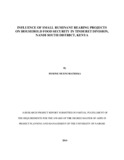| dc.description.abstract | Achieving food security remains an elusive goal to many developing countries, with nearly all of the 929 million undernourished people coming from the developing countries, sub-Saharan Africa where Kenya lies contributes 25% of the world’s malnourished population. The persistence of the hunger problem in Kenya calls for diversification from crop production in tackling the scourge. Small ruminants rearing has been shown in other areas to improve the food situation through increased income, increased food production, improved nutritional intake as well as empowering all genders to participate in tackling the food issue. The study sought to answer the following questions: To what extend do small ruminants rearing project influence household income in Tinderet division? How do small ruminants rearing projects influence food production in Tinderet division? How is the influence of small ruminants rearing projects to household nutritional intake in Tinderet division? How do small ruminants rearing projects influence household power dynamics in Tinderet division? The study delimited itself to Tinderet division and to a questionnaire as research tool. The study adopted a descriptive research design and a questionnaire was used as the data collection tool. The target population for this study was households in Tinderet division who had kept small ruminants for at least two years at the time of the data collection. Pilot testing was undertaken in Nandi Hills division which borders Tinderet and has nearly similar characteristics by administering Questionnaires to the household heads of the sampled households, analyzing the data, making improvements to the questionnaire and taking it back for re-testing until the tool was satisfactory. The questionnaire was reviewed and critiqued by professionals for content validation. A sample size of 367 households was arrived at using the Krejcie and Morgan (1970) Chart and was spread using the multi-stage sampling method. Collected data was cleaned and analyzed using descriptive statistics with an aid of SPSS and Microsoft excel. Findings from the study showed that household income from small ruminants for 153 (43.7%) was below KShs 6000, for 126 (36%) was KShs 6000-12000, for 58 (16.6%) was 12001- 24000, for 9(2.6%) and 4 (1.2%) earned KShs. 24001-36000 and above KShs. 36000 respectively. It further showed that organic manure was less utilized compared to inorganic manure, however, small ruminants were one of the major source of funds for purchase of fertilizers. About 30% of animal protein sources was from small ruminants’ products hence the second contributor to improved nutritional intake. On gender issues in food security, the study reported that women were very much involved in small ruminants rearing but their involvement was limited to the manual work with no control over the income from the sale of the animals or their products. The study concluded that small ruminant rearing positively influences food security through increased household income, improved food production, heightened nutritional intake and gender issues were hindering the optimal utilization of their potential. The researcher recommends that the government to embark on sensitization on agribusiness coupled with high quality extension services to make farmers exposed on the financial potential in rearing small ruminants. Further, exposure to available market and gender mainstreaming will allow high participation in the small ruminants rearing. Broader studies need to be done to establish how small ruminants can improve food security especially in female headed households, the influence of cultural beliefs, attitudes and practices influence the ownership and disposal of small ruminants and the factors that can motivate farmers to take up small ruminant rearing. | en_US |

